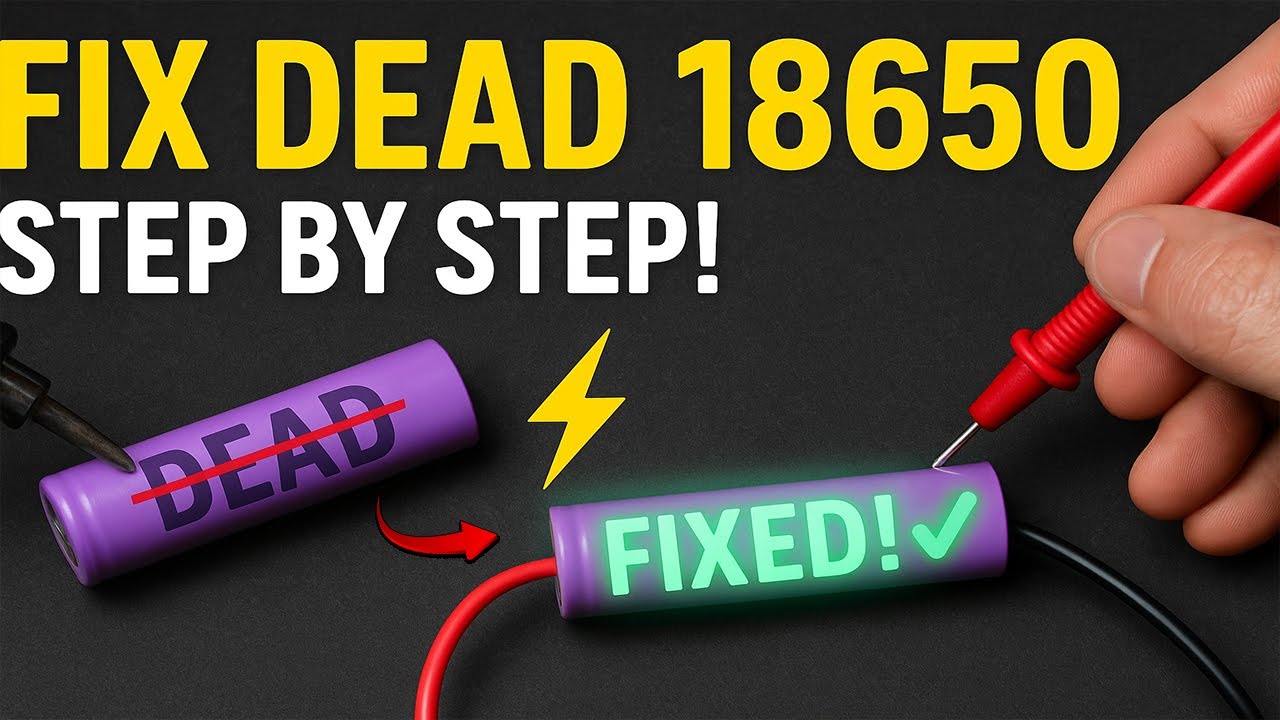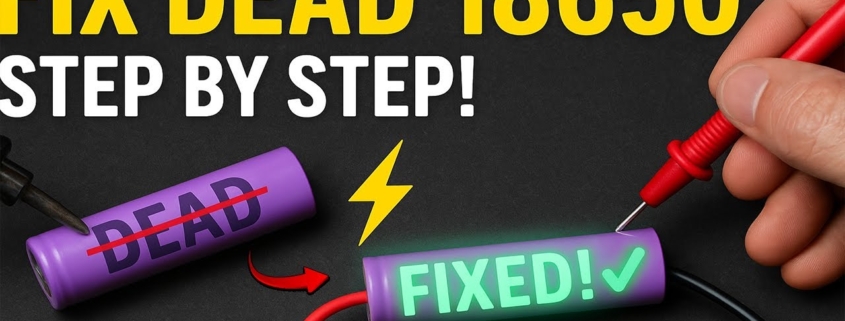How to Bring a 18650 Battery Back to Life? 3 Simple Methods
Ever found a dead 18650 battery and wondered if it’s destined for the recycling bin?
Here’s the thing: Many “dead” 18650 batteries aren’t actually dead. They’re just deeply discharged. And with the right approach, you can often bring them back to life.
I’ve personally revived dozens of 18650 batteries over the years. Some for my flashlights. Others for old laptop battery packs. And while not every battery can be saved, I’d estimate that about 60-70% of “dead” batteries can be successfully revived.
But here’s where it gets tricky:
Reviving lithium-ion batteries can be dangerous if you don’t know what you’re doing. We’re talking potential fires, explosions, and chemical burns.
As a professional 18650 battery pack manufacturer, I’m going to walk you through the EXACT methods I use to safely revive 18650 batteries. Including the tools you need, safety precautions to take, and step-by-step instructions that actually work.
Let’s dive in.

What Makes a 18650 Battery “Dead”?
Before we jump into revival methods, you need to understand WHY your battery died in the first place.
In my experience, 18650 batteries typically “die” for three main reasons:
Deep Discharge: This is the #1 culprit. When a battery’s voltage drops below 2.5V, its built-in protection circuit disconnects it. Standard chargers won’t even recognize it anymore.
Age and Inactivity: Batteries that sit unused for months develop internal resistance. The chemicals inside start breaking down, making it harder for current to flow.
Physical Damage: Sometimes batteries get damaged from drops, extreme temperatures, or manufacturing defects. These are usually beyond saving.
The good news?
If your battery died from deep discharge or inactivity, there’s a solid chance you can revive it.
Safety First: What You NEED to Know
I can’t stress this enough:
Working with lithium-ion batteries is inherently risky.
In fact, according to the U.S. Consumer Product Safety Commission, lithium-ion batteries cause thousands of fires each year.
That’s why you need to take safety seriously. Here’s my non-negotiable safety checklist:
Essential Safety Equipment
- Gafas de seguridad: Protects your eyes from potential chemical splatter
- Heat-resistant gloves: Regular gloves won’t cut it
- Fire extinguisher: Specifically a Class D extinguisher for lithium fires
- Metal container with sand: For emergency battery disposal
- Well-ventilated workspace: Never work with batteries in enclosed spaces
Warning Signs to STOP Immediately
If you notice ANY of these signs, stop what you’re doing and safely dispose of the battery:
- Swelling or bulging
- Visible cracks or damage
- Leaking electrolyte
- Unusual odors
- Excessive heat (above 104°F/40°C)
Trust me on this:
No battery is worth risking your safety. When in doubt, throw it out.
Tools You’ll Need for Battery Revival
Now let’s talk tools.
You don’t need a full electronics lab to revive batteries. But you DO need the right equipment.
Here’s exactly what I use:
Must-Have Tools
Digital Multimeter: This is your most important tool. You’ll use it to check voltage before, during, and after revival. I recommend one that measures to at least two decimal places.
Lithium-Ion Compatible Charger: Not just any charger will work. You need one designed for 18650 batteries. My go-to options are:
- Nitecore i2 Universal Charger
- XTAR VC4 Charger
- Opus BT-C3100
Insulated Connecting Wires: 18 AWG or thicker. Always use proper insulation to prevent shorts.
Optional (But Helpful) Tools
Variable DC Power Supply: Gives you precise control over voltage and current. Great for advanced users.
Battery Holder: Makes connections safer and more stable.
Thermal Camera or IR Thermometer: Helps monitor battery temperature without touching.
How to Bring a 18650 Battery Back to Life?
Method 1: The Trickle Charge Method (Best for Beginners)
This is my go-to method for reviving dead 18650 batteries. It’s the safest approach and has the highest success rate.
Here’s exactly how to do it:
Step 1: Check Initial Voltage
Grab your multimeter and measure the battery voltage.
- Above 2.5V: Use a regular charger
- 2.0V to 2.5V: Perfect for trickle charging
- 1.0V to 2.0V: Still possible but lower success rate
- Below 1.0V: Usually not worth attempting
Step 2: Set Up Your Trickle Charge
Now here’s where most people mess up:
They try to charge at normal speeds. Don’t do that.
Instead, you want to charge at about 0.05C (or 50-100mA for most 18650s). This super-slow charge rate gradually wakes up the battery without causing damage.
If your charger has a “recovery” mode, use it. Otherwise, you can create a trickle charge using a USB charger and resistor.
Step 3: Monitor Progress
This is crucial:
Check the battery every 30 minutes for the first 2 hours. Look for:
- Voltage increase (even 0.1V is progress)
- Temperature (should stay below 40°C/104°F)
- Any physical changes
Step 4: Transition to Normal Charging
Once your battery hits 3.0V, you can switch to normal charging.
Move it to your regular 18650 charger and let it charge fully. This usually takes 3-4 hours.
Success Indicators
How do you know if it worked?
- Battery reaches 4.2V when fully charged
- Holds charge for at least 24 hours
- No excessive self-discharge
In my experience, about 70% of batteries respond well to trickle charging.
Method 2: The Jump Start Method (Advanced)
The jump start method is faster but riskier. I only recommend this if you’re comfortable working with electronics.
Here’s the deal:
You’re basically using a healthy battery to “wake up” the dead one. It’s like jump-starting a car, but way more delicate.
The Process
Step 1: Find a fully charged 18650 battery (must be the same chemistry type).
Step 2: Connect the batteries positive-to-positive and negative-to-negative using insulated wires.
Step 3: Hold the connection for EXACTLY 10-15 seconds. No longer.
Step 4: Disconnect and immediately check voltage.
Step 5: If voltage rose above 2.5V, move to normal charger.
Why This Works
The healthy battery transfers just enough charge to get the dead battery above the minimum voltage threshold. It’s quick but can stress the battery if done wrong.
I’ve used this method dozens of times with about a 50% success rate. But I’ve also seen batteries get dangerously hot when people held connections too long.
Method 3: Variable Power Supply Method (Expert Level)
If you have access to a bench power supply, this gives you the most control.
Here’s my exact process:
Initial Setup
Set your power supply to:
- Voltage: 3.5V
- Current limit: 0.1A (100mA)
This prevents overwhelming the battery while providing enough power to revive it.
The Revival Process
- Connect power supply leads to battery terminals
- Turn on power supply and monitor current draw
- Watch for voltage climb on the battery
- Once battery voltage reaches 3.7V, disconnect
- Move to regular charger for final charging
Why This Works So Well
With a power supply, you can:
- Control exact voltage and current
- Monitor power consumption in real-time
- Stop immediately if something goes wrong
I’d estimate an 80% success rate with this method on batteries above 1V.
Testing Your Revived Battery
So you’ve revived your battery. Now what?
You need to test it properly. A battery that charges doesn’t necessarily mean it’s safe to use.
Capacity Test
The best way to test capacity:
- Fully charge the battery (4.2V)
- Let it rest for 2 hours
- Discharge at 0.5C rate to 2.5V
- Measure total mAh delivered
A healthy 2500mAh battery should deliver at least 2000mAh. Anything less than 60% original capacity isn’t worth keeping.
Self-Discharge Test
This one’s simple but important:
- Charge battery to exactly 4.0V
- Let it sit for 7 days
- Measure voltage again
A good battery loses less than 0.1V per week. More than that indicates internal damage.
When to Give Up and Recycle
Look, I get it:
Nobody wants to throw away a battery that might still work.
But sometimes, you need to accept defeat. Here are my hard rules for when to stop:
Immediate Disposal Triggers
- Zero voltage reading (0.0V)
- Any physical damage or swelling
- Excessive heating during revival
- Failed revival after 24 hours of trying
Performance-Based Disposal
Even if you successfully revive a battery, dispose of it if:
- Capacity below 50% of rating
- Self-discharge exceeds 5% per day
- Voltage drops below 2.5V within a week of charging
Remember: A sketchy battery isn’t worth the risk.
Preventing Future Battery Deaths
Here’s the thing about battery revival:
It’s way easier to prevent battery death than to fix it.
I’ve learned this the hard way after killing dozens of expensive batteries through neglect.
Storage Best Practices
Charge Level: Store batteries at 3.7V (about 40% charge). This minimizes chemical degradation.
Temperatura: Keep them between 15-25°C (59-77°F). Heat is the enemy of lithium batteries.
Mantenimiento periódico: Check and recharge stored batteries every 3-6 months.
Usage Tips
Want your batteries to last longer? Follow these rules:
- Never discharge below 3.0V during use
- Use quality chargers with proper termination
- Avoid fast charging unless necessary
- Keep batteries away from extreme temperatures
I’ve had 18650 batteries last 5+ years with proper care.
Lo esencial
Reviving a dead 18650 battery is definitely possible. I’ve done it successfully many times.
But here’s what you need to remember:
Safety always comes first. No battery is worth risking injury or property damage.
Start with the trickle charge method. It’s the safest and works for most situations. Only move to advanced methods if you’re comfortable with the risks.
And if a battery shows any signs of damage or doesn’t respond to revival attempts? Recycle it properly.
With the right approach and tools, you can bring many 18650 batteries back to life. Just be smart about it.
The real key to success? Understanding that battery revival is as much about knowing when NOT to attempt it as knowing how to do it properly.
Stay safe, and happy reviving!
Now, are you ready to bring that 18650 battery back to life?








